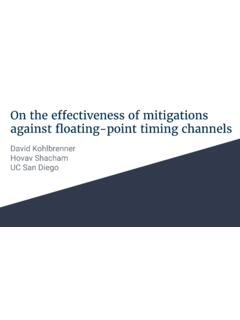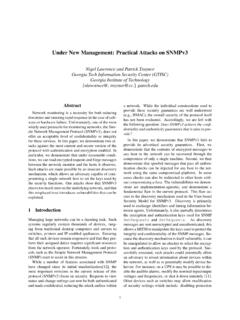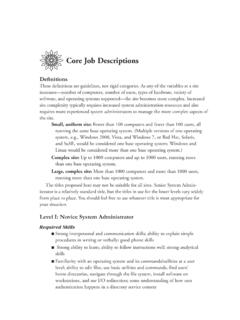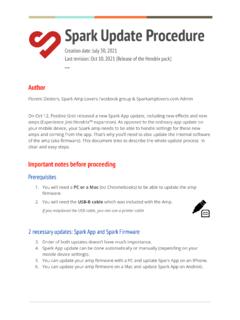Transcription of Spark: Cluster Computing with Working Sets - USENIX
1 spark : Cluster Computing with Working Sets Matei Zaharia, Mosharaf Chowdhury, Michael J. Franklin, Scott Shenker, Ion Stoica University of California, Berkeley Abstract MapReduce/Dryad job, each job must reload the data from disk, incurring a significant performance penalty. MapReduce and its variants have been highly successful in implementing large-scale data-intensive applications Interactive analytics: Hadoop is often used to run on commodity clusters. However, most of these systems ad-hoc exploratory queries on large datasets, through are built around an acyclic data flow model that is not SQL interfaces such as Pig [21] and Hive [1].
2 Ideally, suitable for other popular applications. This paper fo- a user would be able to load a dataset of interest into cuses on one such class of applications: those that reuse memory across a number of machines and query it re- a Working set of data across multiple parallel operations. peatedly. However, with Hadoop, each query incurs This includes many iterative machine learning algorithms, significant latency (tens of seconds) because it runs as as well as interactive data analysis tools. We propose a a separate MapReduce job and reads data from disk.
3 New framework called spark that supports these applica- This paper presents a new Cluster Computing frame- tions while retaining the scalability and fault tolerance of work called spark , which supports applications with MapReduce. To achieve these goals, spark introduces an Working sets while providing similar scalability and fault abstraction called resilient distributed datasets (RDDs). tolerance properties to MapReduce. An RDD is a read-only collection of objects partitioned The main abstraction in spark is that of a resilient dis- across a set of machines that can be rebuilt if a partition tributed dataset (RDD), which represents a read-only col- is lost.
4 spark can outperform Hadoop by 10x in iterative lection of objects partitioned across a set of machines that machine learning jobs, and can be used to interactively can be rebuilt if a partition is lost. Users can explicitly query a 39 GB dataset with sub-second response time. cache an RDD in memory across machines and reuse it in multiple MapReduce-like parallel operations. RDDs 1 Introduction achieve fault tolerance through a notion of lineage: if a A new model of Cluster Computing has become widely partition of an RDD is lost, the RDD has enough infor- popular, in which data-parallel computations are executed mation about how it was derived from other RDDs to be on clusters of unreliable machines by systems that auto- able to rebuild just that partition.
5 Although RDDs are matically provide locality-aware scheduling, fault toler- not a general shared memory abstraction, they represent ance, and load balancing. MapReduce [11] pioneered this a sweet-spot between expressivity on the one hand and model, while systems like Dryad [17] and Map-Reduce- scalability and reliability on the other hand, and we have Merge [24] generalized the types of data flows supported. found them well-suited for a variety of applications. These systems achieve their scalability and fault tolerance spark is implemented in Scala [5], a statically typed by providing a programming model where the user creates high-level programming language for the Java VM, and acyclic data flow graphs to pass input data through a set of exposes a functional programming interface similar to operators.
6 This allows the underlying system to manage DryadLINQ [25]. In addition, spark can be used inter- scheduling and to react to faults without user intervention. actively from a modified version of the Scala interpreter, While this data flow programming model is useful for a which allows the user to define RDDs, functions, vari- large class of applications, there are applications that can- ables and classes and use them in parallel operations on a not be expressed efficiently as acyclic data flows. In this Cluster .
7 We believe that spark is the first system to allow paper, we focus on one such class of applications: those an efficient, general-purpose programming language to be that reuse a Working set of data across multiple parallel used interactively to process large datasets on a Cluster . operations. This includes two use cases where we have Although our implementation of spark is still a proto- seen Hadoop users report that MapReduce is deficient: type, early experience with the system is encouraging. We Iterative jobs: Many common machine learning algo- show that spark can outperform Hadoop by 10x in itera- rithms apply a function repeatedly to the same dataset tive machine learning workloads and can be used interac- to optimize a parameter ( , through gradient de- tively to scan a 39 GB dataset with sub-second latency.)
8 Scent). While each iteration can be expressed as a This paper is organized as follows. Section 2 describes 1. spark 's programming model and RDDs. Section 3 shows The save action evaluates the dataset and writes some example jobs. Section 4 describes our implemen- it to a distributed filesystem such as HDFS. The tation, including our integration into Scala and its inter- saved version is used in future operations on it. preter. Section 5 presents early results. We survey related We note that our cache action is only a hint: if there is work in Section 6 and end with a discussion in Section 7.
9 Not enough memory in the Cluster to cache all partitions of 2 Programming Model a dataset, spark will recompute them when they are used. We chose this design so that spark programs keep work- To use spark , developers write a driver program that im- ing (at reduced performance) if nodes fail or if a dataset is plements the high-level control flow of their application too big. This idea is loosely analogous to virtual memory. and launches various operations in parallel. spark pro- We also plan to extend spark to support other levels of vides two main abstractions for parallel programming: persistence ( , in-memory replication across multiple resilient distributed datasets and parallel operations on nodes).
10 Our goal is to let users trade off between the cost these datasets (invoked by passing a function to apply on of storing an RDD, the speed of accessing it, the proba- a dataset). In addition, spark supports two restricted types bility of losing part of it, and the cost of recomputing it. of shared variables that can be used in functions running on the Cluster , which we shall explain later. Parallel Operations Resilient Distributed Datasets (RDDs) Several parallel operations can be performed on RDDs: A resilient distributed dataset (RDD) is a read-only col- reduce: Combines dataset elements using an associa- lection of objects partitioned across a set of machines that tive function to produce a result at the driver program.















